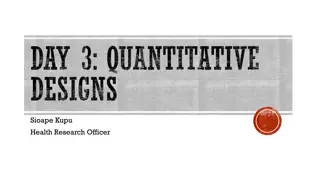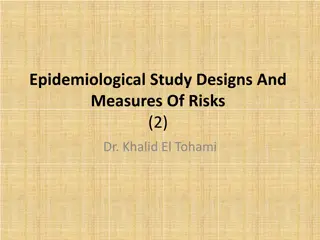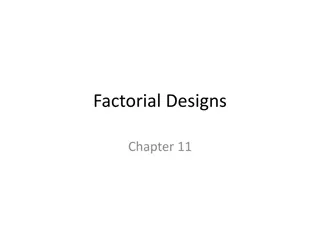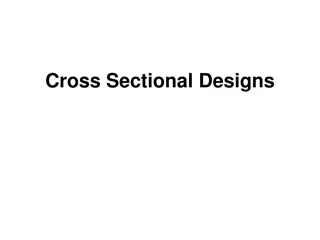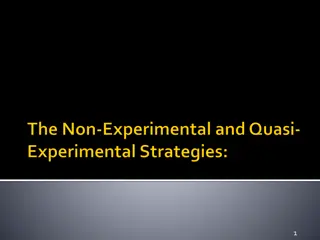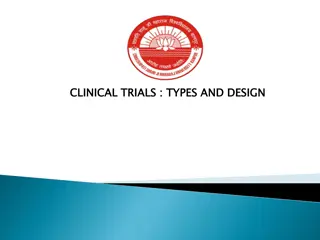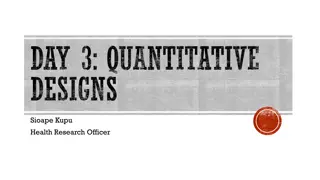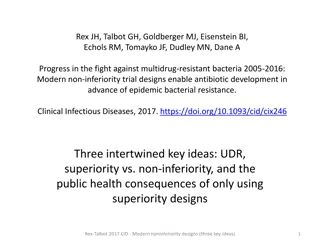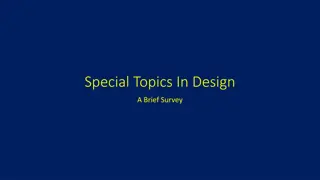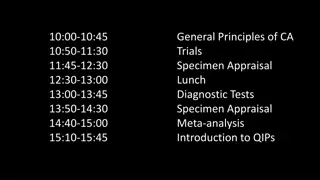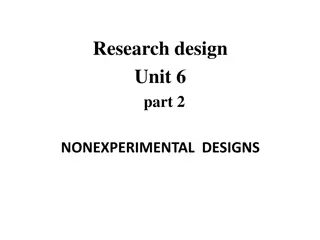
Efficient Overview of Study Designs for Research Success
Explore various study designs and their strengths and limitations for effective research planning. Understand the process of turning a research question into a proposal, minimizing bias and confounding, and planning study details for optimal outcomes.
Download Presentation

Please find below an Image/Link to download the presentation.
The content on the website is provided AS IS for your information and personal use only. It may not be sold, licensed, or shared on other websites without obtaining consent from the author. If you encounter any issues during the download, it is possible that the publisher has removed the file from their server.
You are allowed to download the files provided on this website for personal or commercial use, subject to the condition that they are used lawfully. All files are the property of their respective owners.
The content on the website is provided AS IS for your information and personal use only. It may not be sold, licensed, or shared on other websites without obtaining consent from the author.
E N D
Presentation Transcript
Overview of Study Designs Dr. Mohammed Alahmed Ph.D. in BioStatistics alahmed@ksu.edu.sa (011) 4674108
Objectives Objectives Provide an overview of different types of study designs. Understand the strengths and limitations of each type of study design, as applied to a particular research purpose. Understand key considerations in designing a study, including randomization, matching and blinding.
What is a research question? What is a research question? The researcher asks a very specific question and tests a specific hypothesis. Broad questions are usually broken into smaller, testable hypotheses or questions. Often called an objective or aim, though calling it a question tends to help with focusing the hypothesis and thinking about how to find an answer
Turning a research question into a proposal Turning a research question into a proposal who am I collecting information from? what kinds of information do I need? how much information will I need? * how will I use the information? how will I minimise chance/bias/confounding? how will I collect the information ethically?
Minimising bias and confounding Minimising bias and confounding Chance - measurements are nearly always subject to random variation. Minimise error by ensuring adequate sample size and using statistical analysis of the play of chance Bias - caused by systematic variation/error in selecting patients, measuring outcomes, analysing data take extra care Confounding - factors that affect the interpretation of outcomes eg people who carry matches are more likely to develop lung cancer, but smoking is the confounding factor so measure likely confounders too
Exactly what are you planning to do? Exactly what are you planning to do? PICO P - who are the patients or what s the problem? I - what is the intervention or exposure? C what is the comparison group? O - what is the outcome or endpoint?
Are you going to observe or experiment? Are you going to observe or experiment? Observational cross sectional, case series, case-control studies, cohort studies identify participants observe and record characteristics look for associations Experimental before and after studies, comparative trials (controlled or head to head), randomised trials (ditto) identify participants place in common context intervene observe/evaluate effects of intervention
Cross Cross- -sectional Surveys sectional Surveys Carry out at one point in time to determine if there is a link between exposure and disease providing a snapshot of the frequency and characteristics of disease in a population.
Cross Cross- -sectional Surveys sectional Surveys Example: What is the prevalence of diabetes in the community? Can compare people with vs. without diabetes in terms of characteristics (such as being overweight) that may be associated with the disease. Can t be sure which came first: the diabetes or the weight problem. Thus, this design is very weak for drawing conclusions about causes.
Cross Cross- -sectional Surveys sectional Surveys Pros: Less expensive and simple Ethically safe Cons: Establishes association at most, not causality Recall bias susceptibility Confounders may be unequally distributed
Cohort Studies Cohort Studies These are like surveys, but extend over time (also called longitudinal or prospective studies). You begin with exposure and follow for disease incidence.
Cohort Studies Cohort Studies Basically, Begin with a sample of people who do not have the disease at entry, and take baseline measurements. Follow them over time to collect detailed information. Look to see whether people develop the disease were more exposed to particular factors than those who don t. Allow you to study changes over time and to establish the time-sequence in which times occur.
Cohort Studies: Example Cohort Studies: Example Want to see whether smoking leads to lung cancer. Collect information on how many packs each subject smokes weekly over a long time, and then identify who develops lung cancer. Compare the incidence of cancer among those who have smoked more than a pre-determined amount to the incidence in those who haven t.
Cohort Studies Cohort Studies Pros: Ethically safe Can establish timing of events Eligibility criteria and exposure/outcome assessments can be standardized (exposure= packs per week) Cons: Exposure may be linked to a hidden confounder Blinding is difficult Randomization not present (if present, it s RCT) For rare disease, large sample sizes or long follow-up necessary.
Case Case- -control Studies control Studies It s a retrospective study that works the opposite way to a cohort study. You begin at the end, with the disease, and then work backwards, to hunt for possible causes.
Case Case- -control Studies control Studies In our example, Identify a group of patients with lung cancer and a control group who do not have. To make the results as reliable as possible, you may try to match cases and controls for a variety of general factors, such as age and gender. Then collect info on their smoking habit, dating back as far as you can manage. The testing hypothesis would be that smoking is significantly heavier in the cancer group than the control.
Case Case- -control Studies control Studies Pros: Quick and cheap (but the results may be less reliable) Only feasible method for very rare disorders or those with long lag between exposure and outcome Fewer subjects needed than cross-sectional studies Cons: Reliance on recall or records to determine exposure status Confounders to ensure greater comparability between the two groups and thereby avoid confounding, controls could be matched for sex and age to the cases. Selection of control groups is difficult (who is an appropriate control in your study???) Potential bias: recall, selection
Types of Experimental Study Types of Experimental Study
Randomized Controlled Trials Randomized Controlled Trials Normally used in testing new drugs and treatments. A sample of patients with the condition, and who meet other selection criteria, are randomly allocated (reducing selection and allocation bias) to receive either the experimental treatment or the control treatment (commonly the standard treatment for the condition). Random allocation is completely blinded (reducing performance bias)to participants and/or caregivers. The experimental and control groups are then prospectively followed for a set time and relevant measures are taken to indicate the outcomes in each group.
Randomized Controlled Trials Randomized Controlled Trials Pros: Unbiased distribution of potential confounders Blinding more likely Randomization facilitates statistical analysis. Cons: Expensive: time and money Volunteer bias Ethically problematic at times
Quasi Quasi- -Experimental Designs Experimental Designs Fall between observational (cohort) and experimental studies. There is an intervention, but often not completely planned ahead before conducting the research. Typically, random allocation is not involved. The experimenter doesn t decide to whom the experimental treatment would be applied. The exposed and unexposed are followed forward in time to ascertain the frequency of outcomes. Main drawback: Selection bias can occur.

